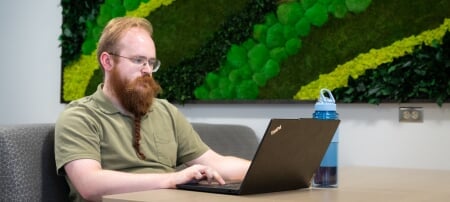From Mountaintop to Desktop: Making Atmospheric Chemistry Accessible to High School Students

If you ask an eighth or ninth grader what a scientist really does, you’re likely to hear plenty about wearing lab goggles and white coats, watching bubbling beakers, and preparing microscope slides. But besides surface-level attributes, many students have trouble explaining what being a scientist actually entails.
That’s exactly the issue Lorentyna Harkness aims to tackle. Harkness is a high school science teacher earning a master’s in applied science education at Michigan Technological University. As part of her degree program, she is teaming up with Tech chemistry and physics faculty to break complex scientific principles into bite-sized chunks for teenage students and to clarify what scientists actually do. And that’s music to Lynn Mazzoleni’s ears.
Mazzoleni, an assistant professor of chemistry, has no shortage of convoluted chemical concepts she’s eager to communicate to colleagues. But she says its always challenging to pare more vexing problems down for general audiences—especially high schoolers.
“For almost ten years, Tech researchers have been studying the composition of trace gases at a mountaintop station in the Azores,” Mazzoleni says. Now, together with three other universities, researchers have set up atmospheric aerosol measurement equipment 7,000 feet above sea level on a picturesque, mountainous island in the middle of the Atlantic. There, a perfect storm of conditions combine to give Mazzoleni’s team access to a critical region of the atmosphere not readily accessible in most locations: the free troposphere.
“Most recently, we’ve looked at the chemical and physical properties of aerosols in the atmosphere,” Mazzoleni says, “like aerosol scattering and absorption—things that can have drastic impacts on climate change.”
One of the biggest challenges she faces isn’t related to the science itself, but in finding an effective way to communicate the work. It’s a problem faced by countless researchers. “Balancing technical concepts with more easily accessible things can be a difficult task,” Mazzoleni says.
That’s where Harkness’s applied science education training comes in handy.
“I was out in the field on the island with the team for part of last summer,” Harkness says. “I came up to do measurements a few times myself and got to take part in their experiments and studies.”
Now that she’s back stateside, Harkness is distilling what she saw into lesson plans for high school earth science teachers nationwide.
“I want to develop research-relevant activities for the classroom—lessons that teach students what science really is,” says Harkness, who lives in the small town of Mason, near Lansing. “When students understand what scientists actually do—learn more about the scientific process, testing hypotheses, conducting experiments—that’s when science teachers succeed.”
As she wraps up her master’s degree, Harkness is contributing to a website for general audiences to showcase educational videos she has made. “I want it to be a resource for teachers, undergrads, graduate students, colleagues from other universities, and even community members,” she says.
Harkness plans to present her findings about developing atmospheric science lesson plans for earth science students at an upcoming American Geophysical Union conference in San Francisco.
Michigan Technological University is an R1 public research university founded in 1885 in Houghton, and is home to nearly 7,500 students from more than 60 countries around the world. Consistently ranked among the best universities in the country for return on investment, Michigan's flagship technological university offers more than 185 undergraduate and graduate degree programs in science and technology, engineering, computing, forestry, business, health professions, humanities, mathematics, social sciences, and the arts. The rural campus is situated just miles from Lake Superior in Michigan's Upper Peninsula, offering year-round opportunities for outdoor adventure.




Comments